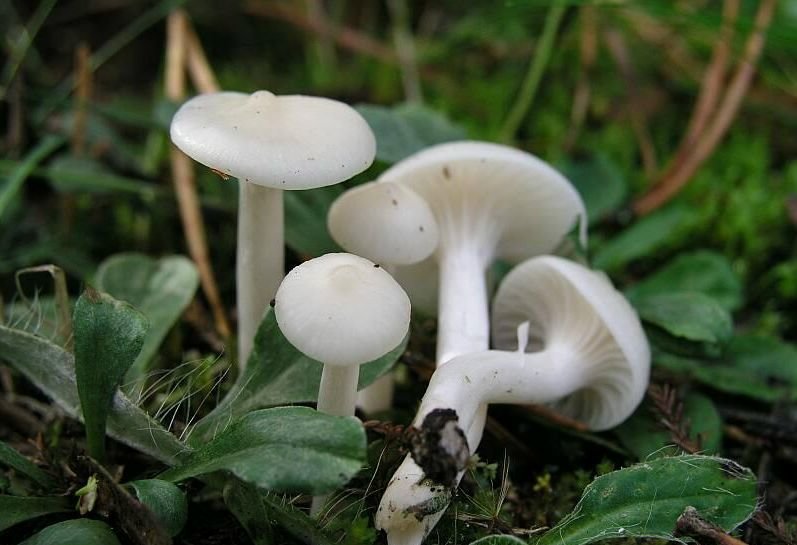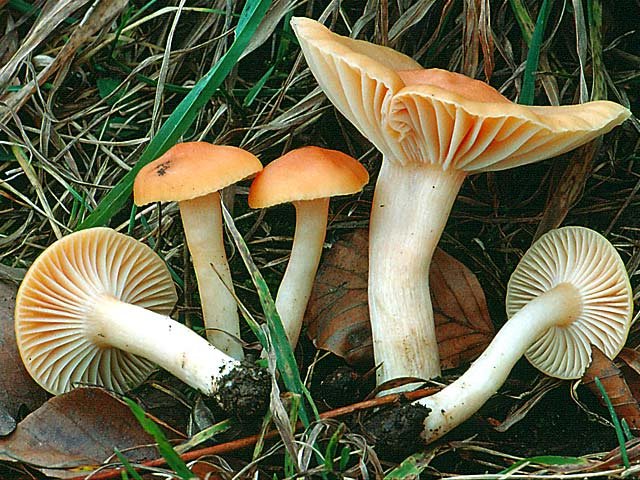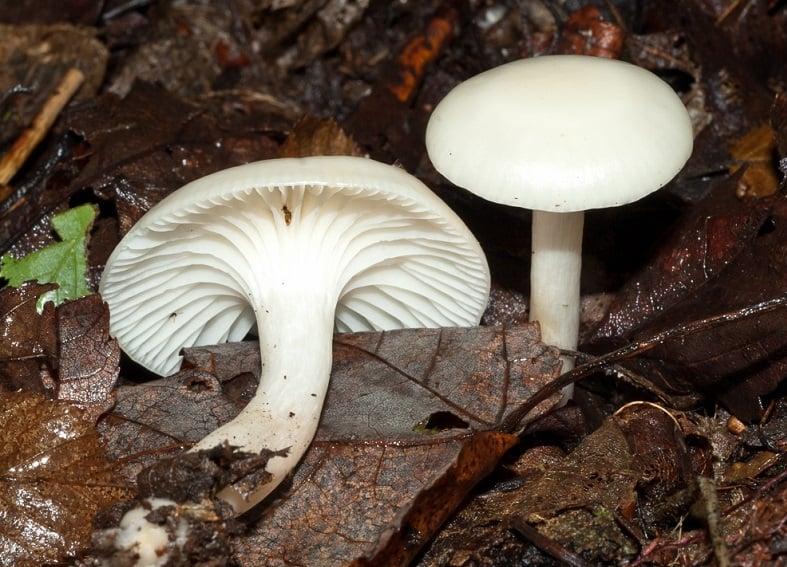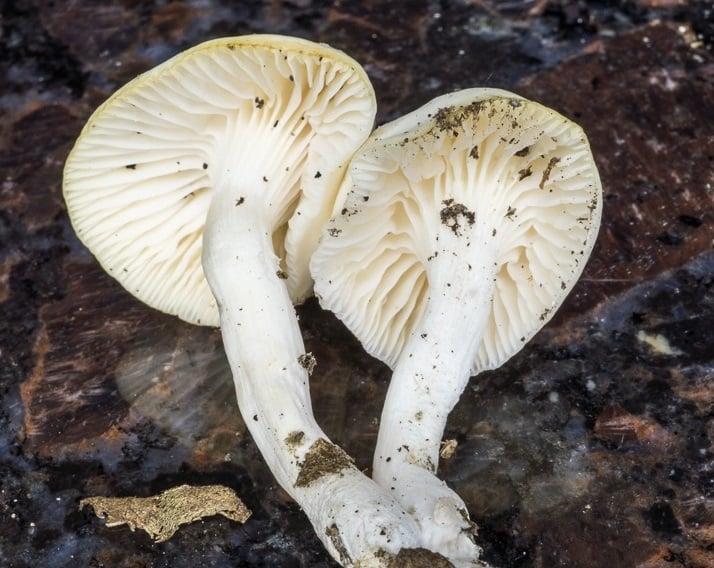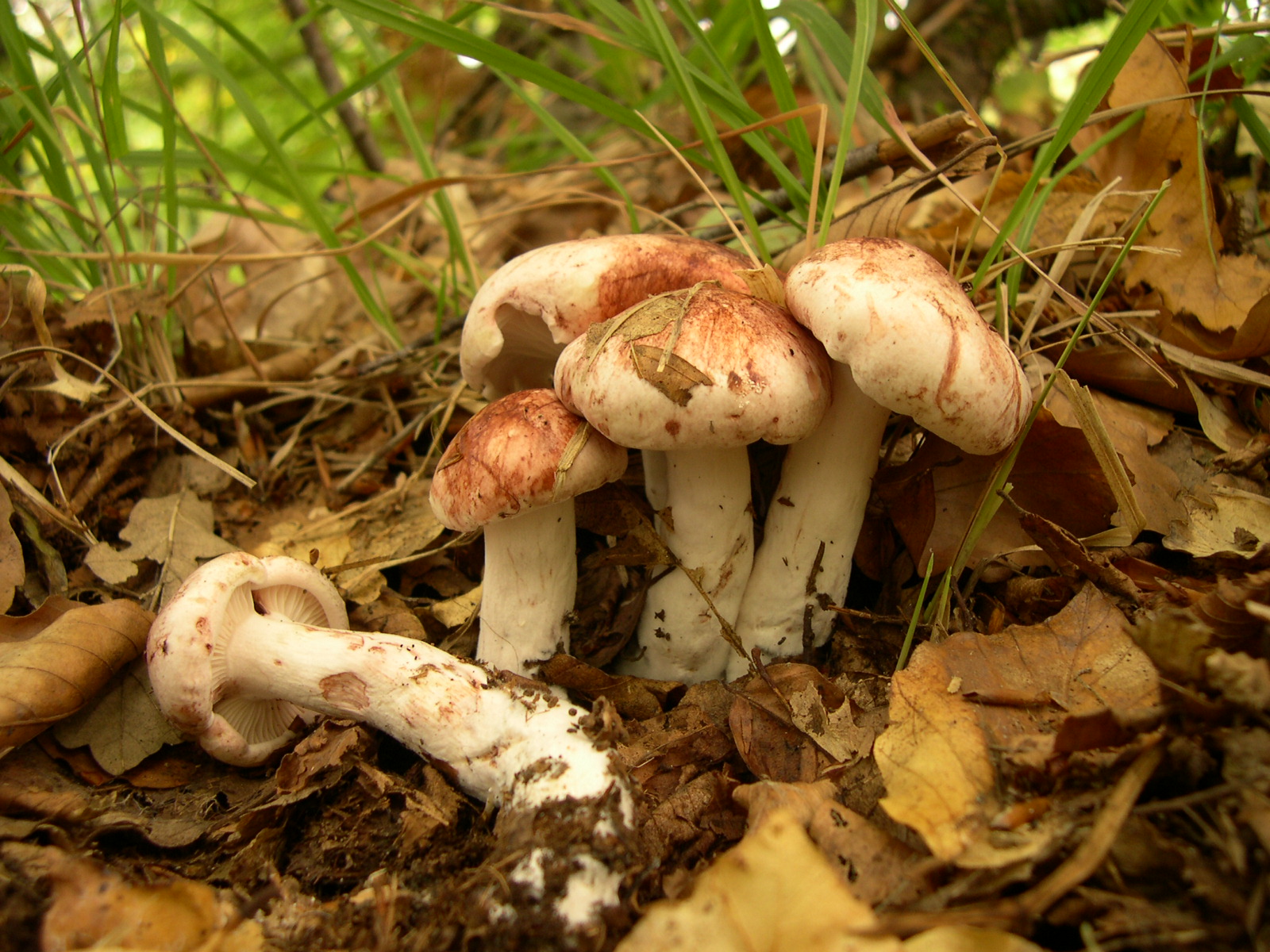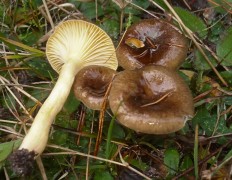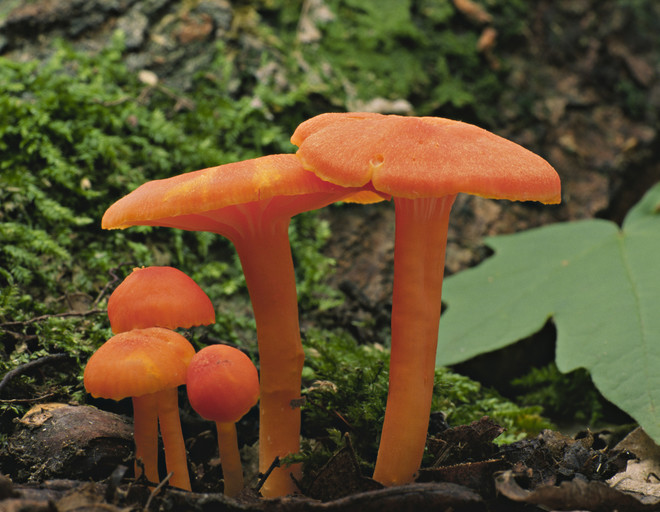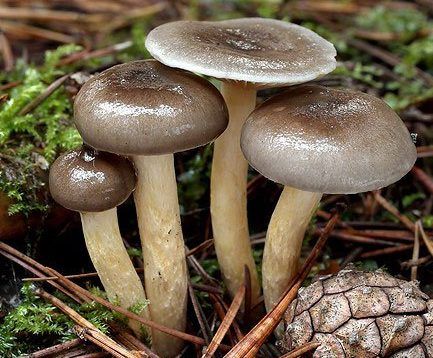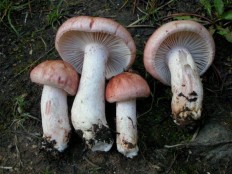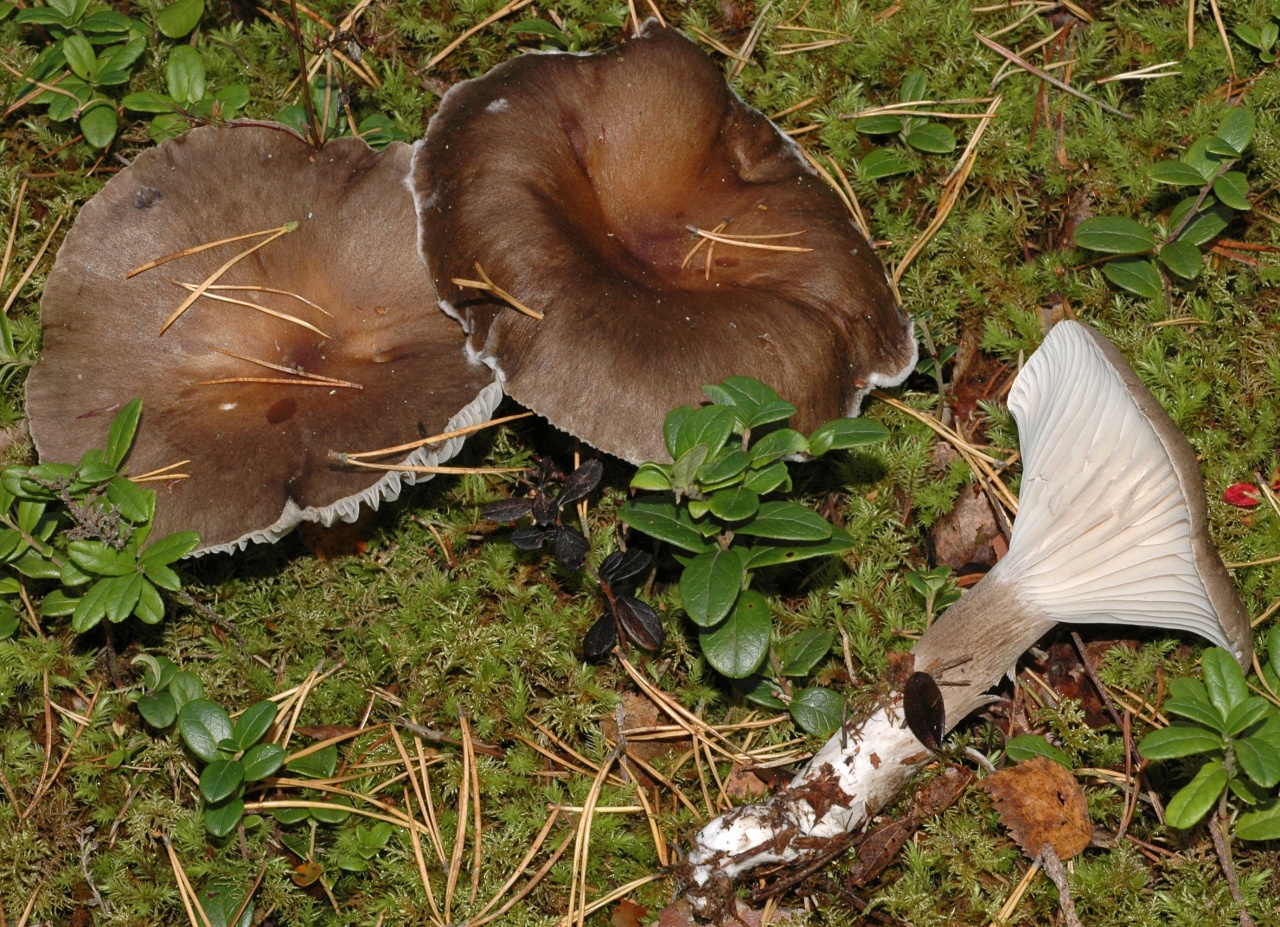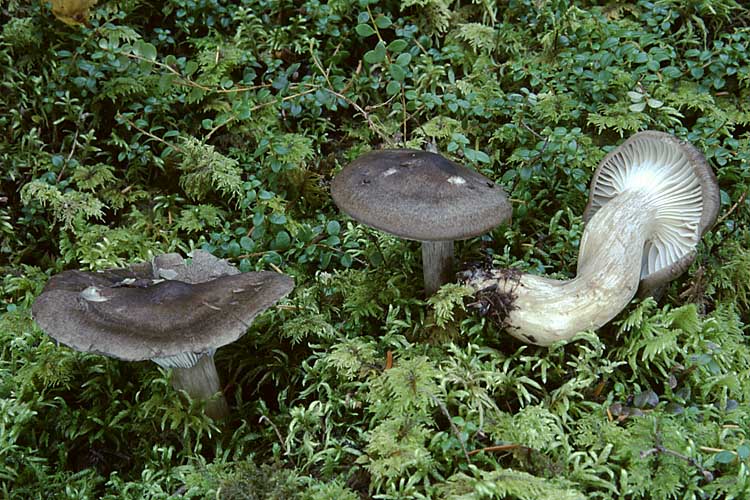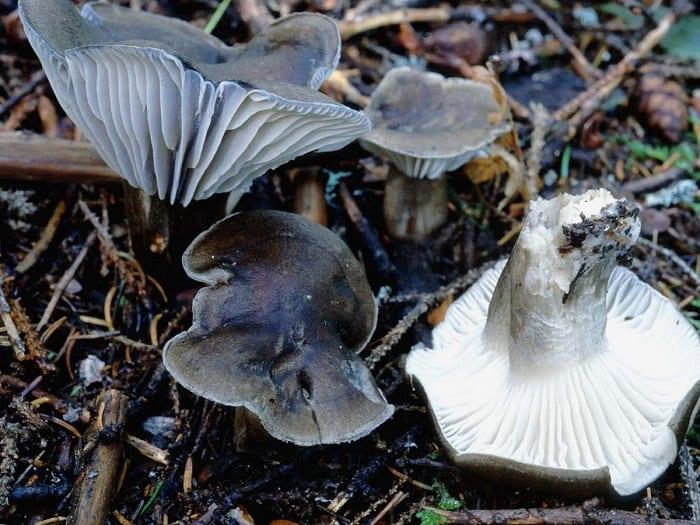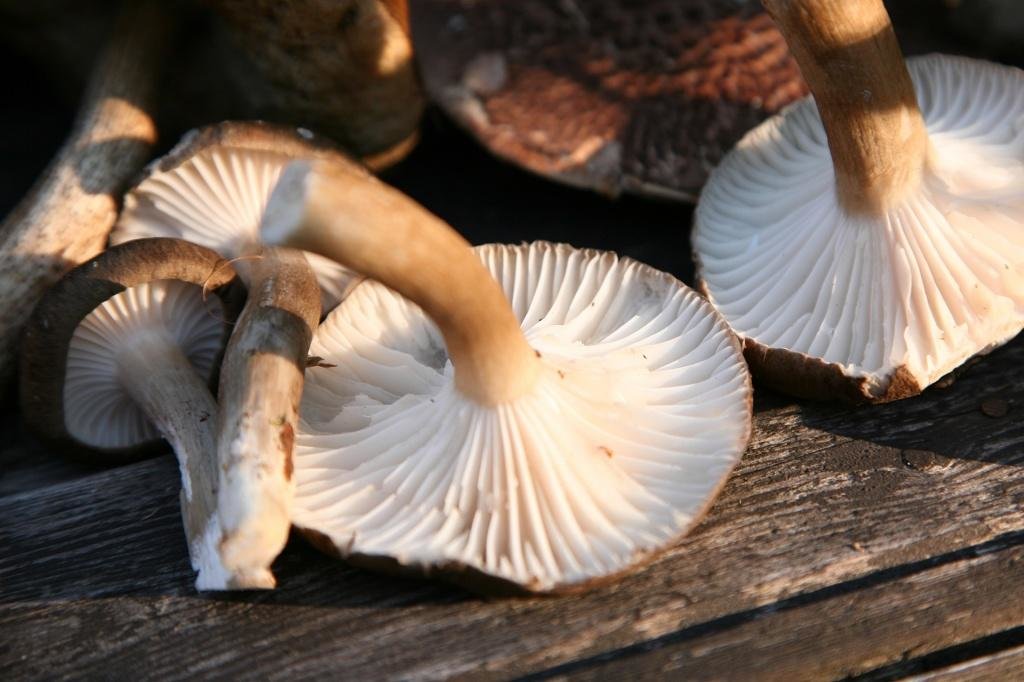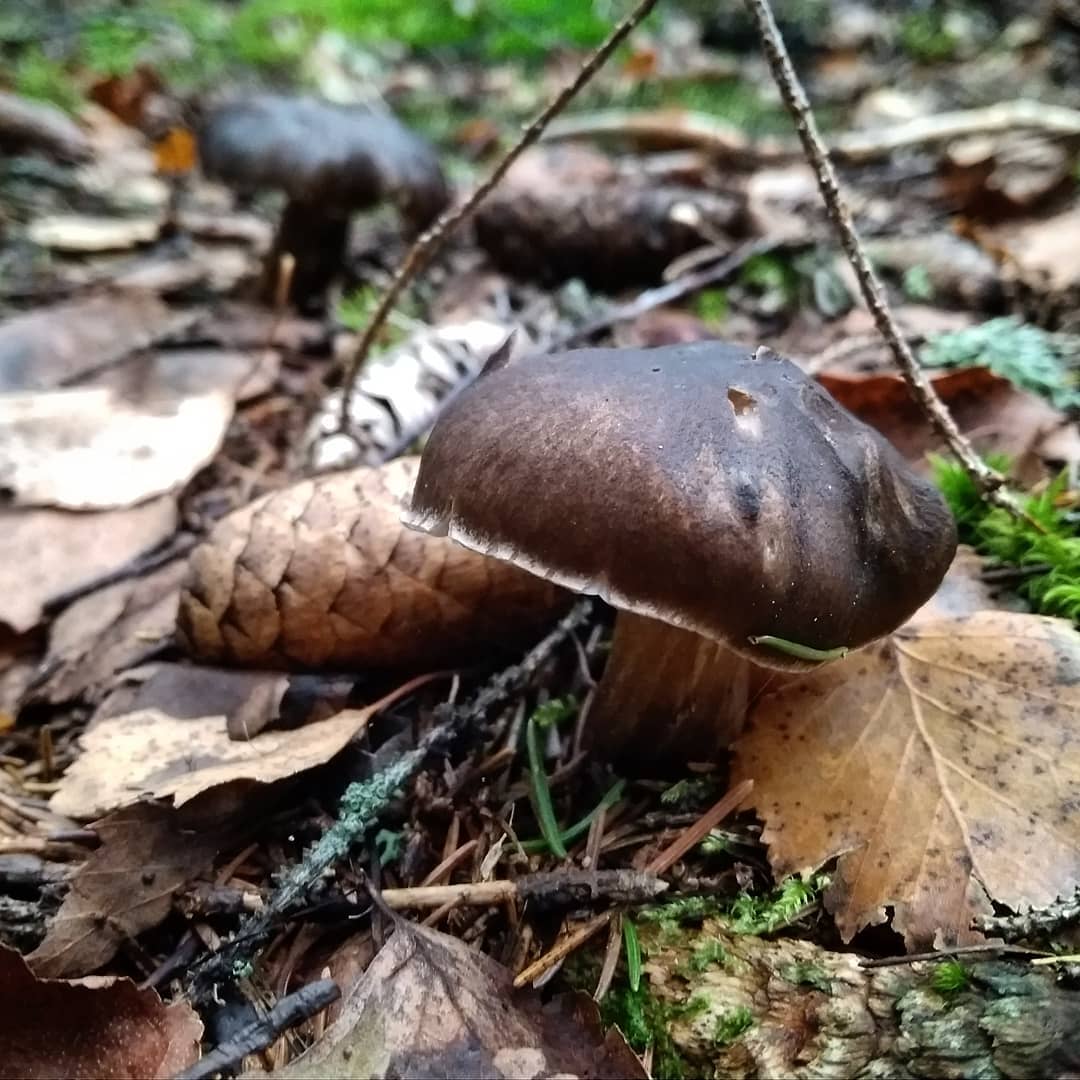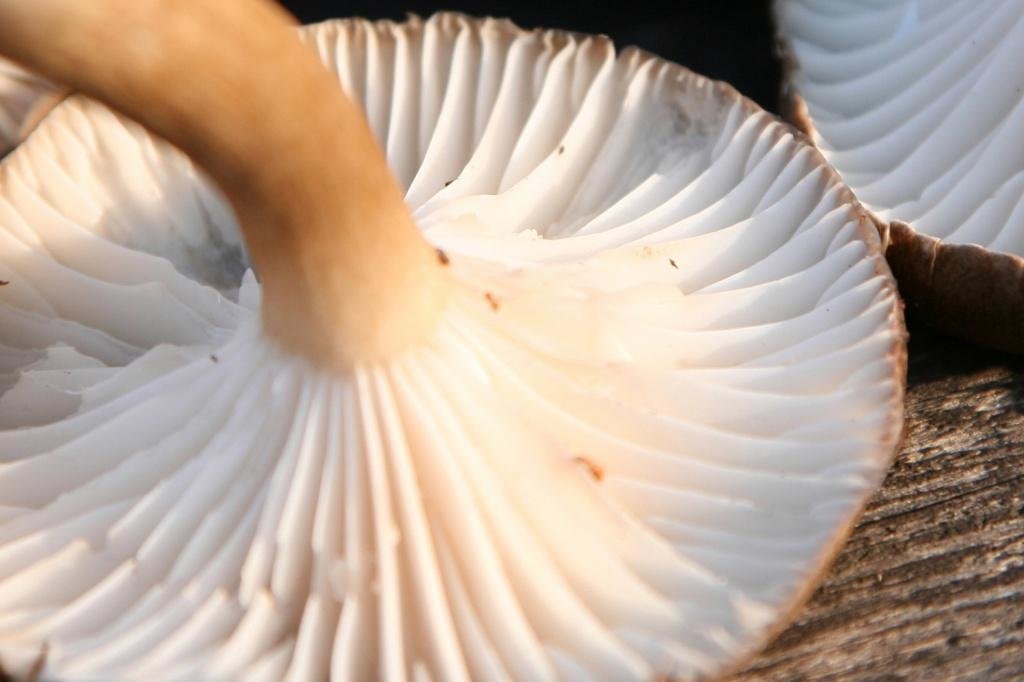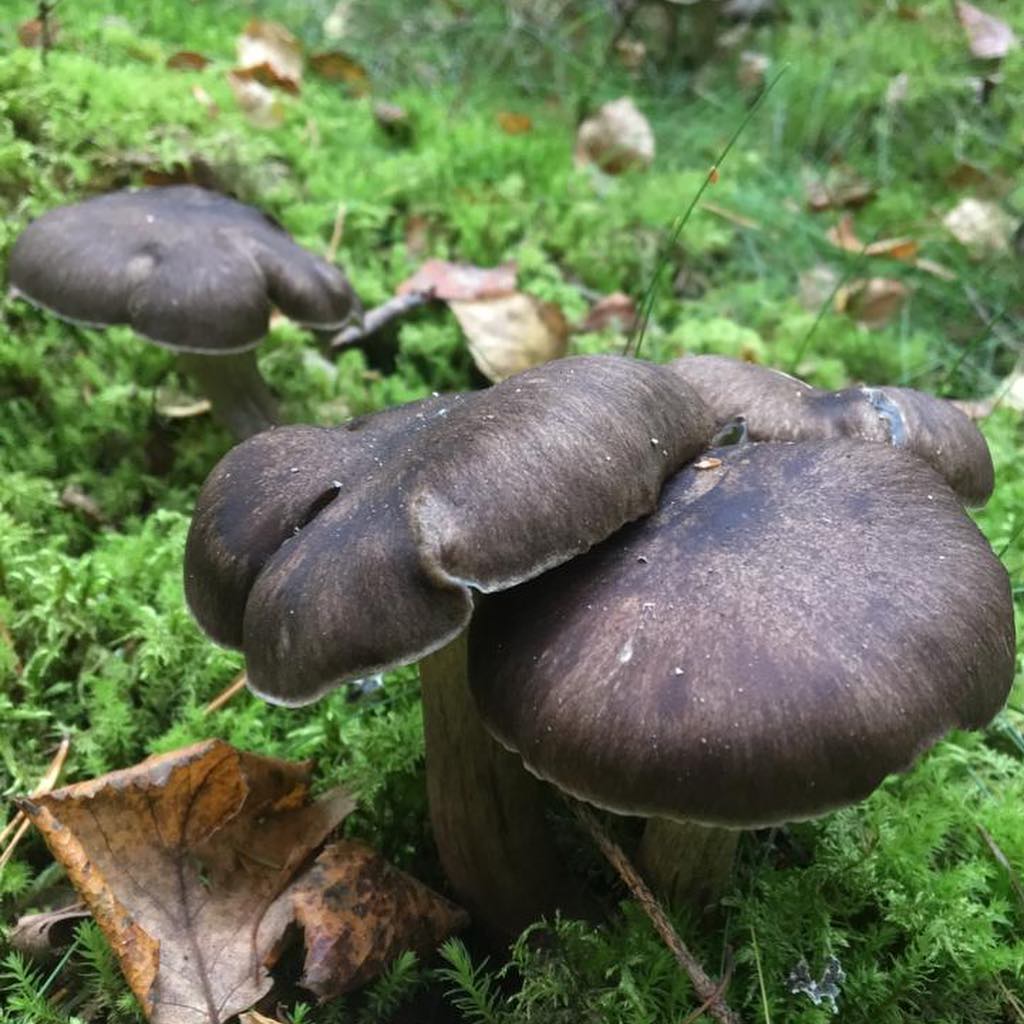Spotted hygrophorus (Hygrophorus pustulatus)
Other names:
Spotted hygrophoric cap:
2-5 cm in diameter, in young mushrooms it is convex, later prostrate, usually with a tucked edge, slightly concave in the center. The surface of the grayish cap (lighter at the edges than in the center) is densely covered with small scales. In wet weather, the surface of the cap becomes slimy, the scales are not so noticeable, which can make the mushroom as a whole look lighter. The flesh of the cap is white, thin, fragile, without any special smell or taste.
Plates:
Rare, deeply descending on the peduncle, white.
Spore powder:
White.
Spotted hygrophoric stem:
Height - 4-8 cm, thickness - about 0.5 cm, white, covered with noticeable dark scales, which in itself is a good distinguishing feature of the spotted hygrophor. The flesh of the leg is fibrous, not as fragile as in the cap.
Spreading:
Gigroforus spotted occurs from mid-September to late October in coniferous or mixed forests, forming mycorrhiza with spruce; in good seasons it bears fruit in very large groups, although the general inconspicuousness does not allow this worthy hygrophor to gain fame.
Similar species:
Wrong formulation of the question. There are a lot of hygrophors, similar to each other, like two drops of water. The value of Hygrophorus pustulatus is that it is different. In particular, noticeable pimply scales on the stem and cap, as well as large-scale fruiting.
Edible: Edible, like the vast majority of hygrophors; however, it is difficult to say exactly how much. It is considered a little-known edible mushroom with a delicate sweetish taste; it is used fresh (boiling for about 5 minutes), in soups and main dishes.
Remarks
The hygrophors themselves are very interesting mushrooms, with their own inner meaning. Just like Lao Tzu said that a noble man should be like a crooked dry tree growing the devil knows where (so that no one cares about him), so hygrophors are small nondescript mushrooms growing on poor soils, forming mycorrhiza with poor grasses and timid trees, they do not pretend to anything special, but they stand firmly on their feet. The same spotted hygrophor, for example, could compete in popularity with some kind of honey fungus and chanterelle. However, he does not argue. He doesn't need to be collected. He lives in harmony with his surroundings, somehow avoiding greedy human attention, and not even hiding (hiding, as we know from the example of a truffle, does not help either), but just somehow. True Tao cannot be expressed in words, but it can be expressed by mushrooms. It's all.
Description of the early hygrophor
The diameter of the cap ranges from 4 to 10 centimeters. At a young age, the shape of the cap is rather convex, but over time it changes to flat, and sometimes it can become depressed. Often, the cap is slightly wavy, due to the uneven edges. The hat is fleshy. While the mushroom is growing, the color of the cap is whitish or slightly gray, but later the color darkens, becomes almost black and spots appear.
The pulp of the early hygrophor is dense. It is initially white in color, but becomes light gray as it grows. The leg is short - no more than 8 centimeters long and thick. Its shape is cylindrical, slightly curved. The color of the leg is most often white, but it can also be grayish, with a slight silver tint. The upper part of the leg under the cap is covered with small scales.

The plates are sparse and thick. Between the main thick plates there are intermediate ones. Both types of plates go down the stem. The plates of young mushrooms are whitish in color, and with age they turn gray. Spores are smooth, colorless. Spore sac of white color.
Distribution of the early hygrophor
A distinctive feature of this species, as noted, is its earlier appearance, and this behavior is not typical for other members of the genus. Early hygrophors appear in March, even during cold weather. The main place of distribution is coniferous and deciduous forests, sometimes these mushrooms can hide in needles and foliage.
Most often, the early hygrophor can be found under the beeches. This mushroom cannot be confused with other hygrophorors and poisonous mushrooms due to their early appearance.

Eating early hygrophoric food
Early Gigrofor is an edible mushroom. Its pulp is dense. There is no pronounced smell, but the subtle smell is quite pleasant. The taste of the early hygrophor is rather high. In addition, this mushroom is especially appreciated by chefs because it can be found when other fresh mushrooms are not yet available.
Most often, soups are prepared from these mushrooms, but they also make delicious side dishes for meat dishes.

Similar species
A related species of the early hygrophor is the parrot hygrophor, or the motley hygrophor, or the parrot hygrocybe. The cap of this mushroom is bell-shaped at first, but then becomes prostrate, and a wide tubercle remains in the center. Its diameter is 4-5 centimeters. The edges of the cap are uneven. The surface of the cap is smooth and shiny due to the gelatinous adhesive surface. The mushroom got its name from the color of the cap, which varies from bright yellow to greenish. With age, the mushroom takes on a wide variety of shades of pink and yellow.

The leg of the parrot's hygrophor is thin and fragile, inside it is hollow, and outside, like the cap, it is covered with mucus. The color of the leg is yellowish with a green tint. Wide infrequent yellow plates.
The pulp is fibrous, smells like earth, almost tasteless. The color of the flesh is white with green or yellow spots.
The variegated hygrophor is found in forest glades and meadows, giving preference to mountainous terrain. Mushrooms grow in large groups. Fruiting in summer and autumn. These mushrooms can be eaten, but they have no nutritional value.
Types of mushroom hygrophor
Fragrant, aromatic, or fragrant hygrophorus (Hygrophorus agathosmus)
An edible mushroom with a fleshy fruiting body. The hat is 4-8 cm in diameter, convex in shape, gradually becomes flat-convex, the edge is tucked up, the surface is sticky and slimy, especially at high humidity. The color of the cap is gray, yellowish brown or off-white, rarely with a green tint. The plates are rare, grow to the stem, white. The flesh is whitish or pale gray in color, soft, with a strong aroma reminiscent of bitter almonds, celery or anise, and a bland taste. The length of the leg is 4-10 cm, the thickness is 0.6-1.5 cm. The leg is central, cylindrical, dry or wet, the surface is not mucous. The color of the leg is white, gradually turning gray. Spores are white.
Grows from August to September in coniferous and mixed forests. Widespread in temperate climates.
Hygrophorus yellowish white (Hygrophorus eburneus)
Edible mushroom, also known as ivory wax bonnet and cowboy handkerchief. Found in Europe, North America, North Africa.
The fruit body is white. In wet weather, the hat becomes covered with a thick layer of mucus. Feels like wax.
Early hygrophorus (Hygrophorus marzuolus)
A rare species, which is also found under the names of the hygrophor of March and snow mushroom. The diameter of the cap is 4-10 cm, the structure is thick, fleshy, the shape of the young mushroom is convex, flattens with age. The surface is curved, the edges are wavy. The skin is smooth, dry, slightly pubescent. In young mushrooms, the cap is light gray or whitish, in mature ones it is lead-gray or blackish with spots. The pulp is dense, white, turns gray with age. The aroma is weak, pleasant, the taste is not expressed. The leg is 3-8 cm long, 1.5-4 cm wide, cylindrical, curved, solid, thinning downwards. The color is whitish or gray, with a silvery tint. Spores are white.
Unlike other hygrophors, the species is very early, appears in March and grows until the beginning of May. It is found in coniferous and deciduous forests, often under beeches.
An edible mushroom used in soups and garnishes for meat dishes. Since the March hygrophor appears very early, it cannot be confused with other mushrooms, including poisonous ones.
Hygrophorus olive-white (Hygrophorus olivaceoalbus)
The diameter of the cap is 2-6 cm, the shape is hemispherical in young mushrooms, in old ones it is convex or flat, covered with a layer of mucus. The color of the cap is gray-brown or olive-brown, darker in the center, becomes lighter as it matures. The pulp is strong, white, yellow in the center, the pulp is fibrous in the stem. Aroma and taste are poorly expressed. The stem is 4-8.5 cm long and 0.4-1.0 cm thick, central, cylindrical or fusiform, olive-brown color. Spores are white.
An edible mushroom that is eaten fresh.
It grows from August to November in coniferous and mixed forests next to spruce. Widely distributed in Eurasia.
Gigrofor russula or russula (Hygrophorus russula)
A fleshy edible mushroom that grows in the deciduous forests of the Northern Hemisphere.
The diameter of the cap is 5-12 cm, the shape is hemispherical, gradually becoming convex, flattened, the edge is turned up. The surface is smooth, in wet weather it becomes sticky-mucous, in young mushrooms it is whitish or pinkish in color, with pink spots, then it becomes pink-red and in a mature mushroom - wine-red. The pulp is dense, white, pinkish on the cut, the smell is weak, flour, the taste is not pronounced. The leg is 6-8 cm long, 1-2.5 cm thick, central, tapering downward, clavate or fusiform, white with pinkish-brown spots. Spores are white.
Edible mushroom, used fresh, pickled or salted. It is considered the best in taste of all species of the family.
It grows from August to November in deciduous and mixed forests, next to an oak tree.
Growing a hygrophoric mushroom
Gigrofor can be grown at home. To do this, you will need a mycelium powder available in specialty stores. One package of such a powder is designed for 1 sq. m. area. Before sowing, the seeds should be mixed with a little dry soil or sand. The place for breeding the hygrophor is chosen under the trees.
The soil must be loosened to get a depression of 5-15 cm. Sprinkle a mixture of mycelium with sand on the prepared surface. Cover the top with forest or garden soil with the addition of humus.
Carefully water the site at the rate of ten liters of water per square meter of area. After that, pour the earth from above, which remained after loosening the soil. Planting mycelium can be done at any time of the year and under any type of tree. You can harvest four times a year: twice in the spring and the same in the fall.
The mushroom picker will delight you with fruits all the years as long as the tree is alive. Fertilize with humus every year to maintain high yields. This should be done only during the period when the mushrooms are not growing.
Sometimes hygrophors are grown indoors, like champignons. But this method gives a small yield and a low percentage of germination.
Although the hygrophor is not very popular among fans of "quiet hunting", it also has its fans. He deserves it with his wonderful taste and aroma, which will decorate any dish.
Useful properties and contraindications
- normalizes the work of the central nervous system;
- improves the functioning of the gastrointestinal tract;
- restores the lymphatic system thanks to biologically active components;
- prevents obesity;
- reduces the risk of complications in type 2 diabetes mellitus;
- strengthens the body's immune defenses;
- normalizes hepatic function;
- improves the functioning of the organs of the genitourinary system;
- increases the activity of the optic nerve.
Any drug not only has a positive effect on the body, but can provoke a negative reaction.
Important! The use of hygrophors is prohibited for people who have problems with metabolic processes, allergy sufferers, suffering from epileptic seizures. In some cases, medical staff recorded the development of hypervitaminosis in people after eating mushrooms .. The fruiting body is rich in protein, therefore, kidney disorders are often observed
In addition, fungi accumulate toxic substances. Experts advise to refrain from preparing fruits collected near highways, factories. This can lead to serious poisoning of the body. It is forbidden to eat any mushroom dishes for pregnant and lactating women, as well as children under 12 years old
The fruit body is rich in protein, therefore, violations in the functioning of the kidneys are often observed. In addition, fungi accumulate toxic substances. Experts advise to refrain from preparing fruits collected near highways, factories. This can lead to serious poisoning of the body. It is forbidden to eat any mushroom dishes for pregnant and lactating women, as well as children under 12 years old.
Gigrofor golden edibility, where it grows, what it looks like, collection rules, photo
Gigrofor golden: is it possible to eat, description and photo
Golden Gigrofor is a lamellar mushroom of the Gigroforov family. This species grows in small groups, forming mycorrhiza with different trees. In other sources, it can be found under the name of the golden-toothed hygrophor. In scientific circles, it is listed as Hygrophorus chrysodon.
What does the golden hygrophor look like?
The fruiting body of this species is of the classical type. The hat initially has a convex bell-shaped shape with an edge concave downward. As it ripens, it straightens out, but a small tubercle remains in the center. The surface is smooth, sticky, covered with thin scales closer to the edge. In young specimens, the color of the upper part is whitish, but later it becomes golden yellow. The diameter of the cap reaches from 2 to 6 cm.
The pulp is watery, soft. It is characterized by a light shade and does not change when cut. The smell is mild, neutral.
On the reverse side of the cap there are rare wide plates descending to the pedicle. The hymenophore initially has a whitish tint, and then becomes yellow. The golden hygrophor has white elliptical spores with a smooth surface. Their size is 7.5-11 x 3.5-4.5 microns.
The leg is cylindrical, narrowed at the base, sometimes slightly curved. Its length reaches 5-6 cm, and its width is 1-2 cm. In young fruits, it is dense, and then a cavity appears. The surface is sticky, white, with a light fluff closer to the cap and yellow scales along the entire length.
Where does the golden hygrophor grow
This mushroom is common, but it grows singly or in small groups. Prefers conifers and deciduous forests with humus-rich soil. Forms mycorrhiza with oak, linden, pine. The fruiting period begins in mid-August and continues through the second decade of October inclusive.
The golden hygrophor is widespread in Europe and North America. On the territory of Russia, it is found everywhere.
Is it possible to eat a golden hygrophor
This mushroom is considered edible. But it does not possess high taste, therefore it belongs to the fourth category.
False doubles
At the initial stage of development, the gigrofor is golden in many ways similar to its relatives. Therefore, in order to avoid error, it is necessary to study the characteristic differences of twins.
- Fragrant gigrofor. It has a pronounced almond scent, and in rainy weather it can spread for several meters around. You can also distinguish it by the gray-yellow shade of the hat. This mushroom is considered conditionally edible and is characterized by a sweetish pulp taste. The official name is Hygrophorus agathosmus.
- Gigrofor is yellowish-white. The fruiting body is medium in size. The main color is white.A distinctive feature is that when rubbed, wax is felt on the fingers. The mushroom is edible, its official name is Hygrophorus eburneus.
Collection rules and use
Mushroom picking should be done with a sharp knife, cutting off the fruiting body at the base. This will prevent damage to the mycelium.
Before use, forest fruits must be cleaned of litter and soil particles. Then rinse the mushrooms thoroughly. It can be consumed fresh and processed.
Conclusion
Gigrofor golden belongs to the category of unpopular, but edible mushrooms. This is due to its poor fruiting, which makes harvesting difficult, and its neutral taste. Therefore, most mushroom pickers bypass it. Since during the fruiting period, more valuable species can be harvested.
Definitioner
- Basidia (Basidia)
-
Lat. Basidia. A specialized structure of sexual reproduction in fungi, inherent only in Basidiomycetes. Basidia are terminal (end) elements of hyphae of various shapes and sizes, on which spores develop exogenously (outside).
Basidia are diverse in structure and method of attachment to hyphae.
According to the position relative to the axis of the hypha, to which they are attached, three types of basidia are distinguished:
Apical basidia are formed from the terminal cell of the hypha and are located parallel to its axis.
Pleurobasidia are formed from lateral processes and are located perpendicular to the axis of the hypha, which continues to grow and can form new processes with basidia.
Subasidia are formed from a lateral process, turned perpendicular to the axis of the hypha, which, after the formation of one basidium, stops its growth.
Based on morphology:
Holobasidia - unicellular basidia, not divided by septa (see Fig. A, D.).
Phragmobasidia are divided by transverse or vertical septa, usually into four cells (see Fig. B, C).
By type of development:
Heterobasidia consists of two parts - hypobasidia and epibasidia developing from it, with or without partitions (see Fig. C, B) (see Fig. D).
Homobasidia is not divided into hypo- and epibasidia and in all cases is considered holobasidia (Fig. A).
Basidia is the place of karyogamy, meiosis and the formation of basidiospores. Homobasidia, as a rule, is not functionally divided, and meiosis follows karyogamy in it. However, basidia can be divided into probasidia - the site of karyogamy and metabasidia - the site of meiosis. Probasidium is often a dormant spore, for example in rust fungi. In such cases, probazidia grows with metabasidia, in which meiosis occurs and on which basidiospores are formed (see Fig. E).
See Karyogamy, Meiosis, Gifa.
- Pileipellis
-
Lat. Pileipellis, skin - differentiated surface layer of the cap of agaricoid basidiomycetes. The structure of the skin in most cases differs from the inner flesh of the cap and may have a different structure. The structural features of pileipellis are often used as diagnostic features in descriptions of fungi species.
According to their structure, they are divided into four main types: cutis, trichoderma, hymeniderma and epithelium.
See Agaricoid fungi, Basidiomycete, Cutis, Trichoderma, Gimeniderm, Epithelium.
- Pileipellis (Pileipellis)
-
Lat. Pileipellis, skin - differentiated surface layer of the cap of agaricoid basidiomycetes. The structure of the skin in most cases differs from the inner flesh of the cap and may have a different structure. The structural features of pileipellis are often used as diagnostic features in descriptions of fungi species.
According to their structure, they are divided into four main types: cutis, trichoderma, hymeniderma and epithelium.
See Agaricoid fungi, Basidiomycete, Cutis, Trichoderma, Gimeniderm, Epithelium.
- Ixotrihoderma
-
Trichoderma, consisting of hyphae immersed in mucus. The surface of the cap is oily, slippery or slimy.
Lat. Ixotrichoderm.
See Trichoderma, Gifa.
- Ixokutis
-
Cutis, consisting of hyphae immersed in mucus. The surface of the cap is oily, slippery or slimy.
Lat. Ixocutis.
See Cutis, Gifa.
Description
This species received the generic name "hygrophor" (carrying moisture) for its watery pulp. Most of this genus grows in wooded areas and enters into symbiosis with trees. Gigrofor beech, as the name implies, prefers the neighborhood of these particular trees. For the color of the cap, this species is also called Gigrofor ash gray. He also has a purely scientific name: Gigrofor Lindtner (lat.Hygrophorus lindtneri), Hygrophorus leucophaeus (ilicis).
Hat
Like other hygrophors, the mushroom cap has a diameter of 4-15 cm. In young representatives, they are convex, as they grow, they straighten and become flat, sometimes they acquire a concave shape with a tubercle in the center. In the middle, the cap is brown with a rusty tinge, along the edges it is white. It gets a little sticky to the touch in rainy weather.
Hymenophore
Hygrophors are lamellar mushrooms. The Lindtner hygrophor has narrow, rare white plates, sometimes slightly pinkish.
Pulp
The almost white flesh also has a light pink tint. It doesn't smell like anything, but it tastes good. True, it is not consumed in its raw form.
Leg
The stem is dry, hard, light, reddish or pinkish. The bottom is slightly thickened and has notches, in the upper part you can see a powdery coating on it.
Fragrant gigrofor
Family: Hygrophoraceae.
Synonyms: fragrant hygrophor, fragrant hygrophor, gray hygrophor.
Description. The cap is 4-10 cm in diameter, convex, then flat, often with a flat tubercle or depressed, smooth, slimy or slightly sticky, gray, yellowish-gray, sometimes with an olive tint, lighter along the edge (to whitish), sometimes off-white. The plates are rare, thick, white, grayish with age. The pulp is white or grayish, with a strong smell of almonds or anise (or a combination thereof), with an expressionless taste. Stem 5-15 X 0.6-2 cm, cylindrical or narrowed towards the base, dry or wet, with pubescence, mealy-granular bloom or small yellowish scales, at first white, grayish with age.
Fragrant gigrofor is found in coniferous and mixed forests, on calcareous soils, often among mosses, throughout the forest zone of Russia, not often and not abundantly, it forms mycorrhiza with spruce.
Fruiting in August-October.
Similar species. The combination of characteristic odor (anise-almond) and color does not allow this hygrophor to be confused with its other relatives.
Medicinal properties. Studies on antioxidant activity have shown the presence of at least five organic acids: oxalic, citric, malic, quinic and fumaric. In tests for antimicrobial activity, the fungus showed inhibition of the growth of a wide range of bacteria pathogenic for humans: Escherichia coli, Enterobacter aerogenes, Salmonella typhimurium, Pseudomonas aeruginosa, Staphylococcus aureus, S. epidermidis and Bacillus subtilis. Antifungal activity has been shown against the yeast pathogens Candida albicans and Saccharomyces cerevisiae.
Cooking use. An edible mushroom with low palatability, it is eaten fresh, pickled and salted.
The benefits and harms of hygrophors
Useful properties of the late hygrophor:
- calming effect on the central nervous system;
- restoration of the gastrointestinal tract;
- harmonization of the cardiovascular and lymphatic systems;
- antiviral and anti-inflammatory effects;
- prevention of diabetes;
- beneficial effects on the liver and kidneys;
- tonic effect;
- prevention of conjunctivitis;
- correction of muscle mass.
The mushroom belongs to 3-4 categories. 100 g contains 2 g of proteins, 0.7 g of fat, 3.2 g of carbohydrates. Caloric content (per 100 g) is more than 20 kcal.
The pulp of the hygrophor contains vitamins (A, PP, group B), trace elements. Fruits also include calcium, phosphorus, zinc, iodine, sodium, potassium, sulfur, manganese. The composition is nutritious, but has a low calorie content, helps to reduce weight, and helps to remove toxic substances from the body.
 Green Hygrophors
Green Hygrophors
When deciding how to cook a mushroom, it is necessary to take into account the peculiarities of the subspecies. The varieties differ in taste, preparation methods, recipes, and purpose. The use of mushrooms in nutritious soups, cold and hot appetizers, and second courses is widespread. Some varieties can be used for pickles.
When eating mushrooms, it is important to keep in mind some restrictions. Exceeding the standard portion can lead to a change in metabolic processes in the body, provoke an exacerbation of diseases
Occurrence is possible:
- allergies;
- hypervitaminosis;
- disruption of the gastrointestinal system.
It is forbidden to use the hygrophor for lactating and pregnant women with epilepsy. It is not recommended to collect fruits from large transport routes, industrial enterprises, landfills. The porous structure of the fungus absorbs toxic substances.
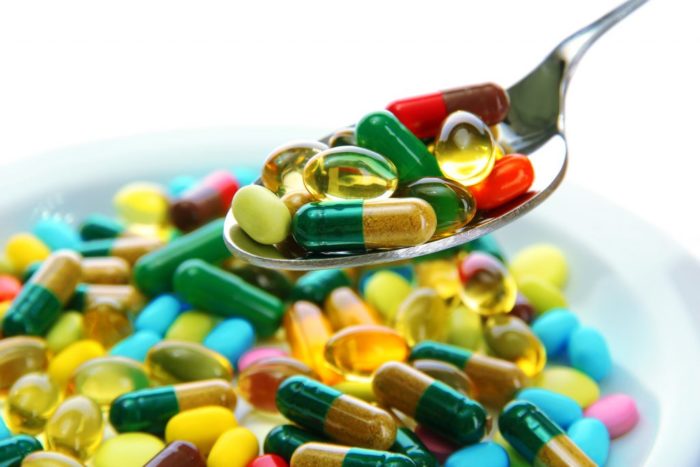 In medicine, dietary supplements are used from components obtained from the mushroom
In medicine, dietary supplements are used from components obtained from the mushroom
External description of the black hygrophor
The shape of the cap of the black hygrophor is at first convex, over time it becomes prostrate, and even later - depressed.
The surface of the cap is smooth and dry, the edges are wavy. The size of the cap can sometimes be quite decent - about 12 centimeters.
The leg is cylindrical, strong in structure, sometimes narrowed at the base. The leg is covered with thin longitudinal grooves. Under the cap of this lamellar mushroom there are rather wide plates. The plates are rarely located, descending along the leg. The color of the plates is first white, and then becomes bluish. The flesh of the mushroom is fragile, white in color.
Evaluation of the taste of black hygrophors
Many Grigroforians look like inedible mushrooms, as they have an unsightly appearance due to their sticky shell. However, the hygrophors are black - not easy edible, but also delicious mushrooms.
A variety of dishes can be prepared from black hygrophors, dried specimens are especially tasty. If dried hygrophors are immersed in water, then within 15 minutes they swell and take on their original shape. The water that remains after soaking the black hygrophors is recommended for cooking, since mineral substances pass from the mushrooms into it.
Places of growth of black hygrophors
Black hygrophors grow in damp mossy forests. They settle in the undergrowth of mountain coniferous forests. In the Southern Federation, this is a common sight. Black hygrophors bear fruit in autumn.
Other mushrooms of this genus
Gigrofor blushing is an edible mushroom. He has a classic look with a domed hat and a rather long leg. When the mushroom is fully ripe, the cap opens. The color is pink-whitish with yellow spots.
Reddening hygrophors grow in coniferous and mixed forests. These mushrooms bear fruit in August and September. They are found mainly under spruce and pine trees. Although they are edible mushrooms, they have no value because they do not have a special taste and smell.
The poetic gigrofor is an edible mushroom. At first, his hat is spherical, and eventually spread out. The skin is silky, smooth, sticky. The leg is very strong and dense, covered with thin silvery fibers, sticky underneath.
The poetic hygrophor is a good edible mushroom that can be prepared in a variety of ways, as well as dried and preserved. These mushrooms grow in small groups in deciduous forests. Most often they are found under beeches. They can grow in hills and mountainous areas. Fruiting from summer to autumn.
Gigrofor russula is an edible mushroom. His hat is fleshy, initially convex, and then flattened. The surface is wavy, sometimes with deep cracks. The cap is covered with a scaly skin. The color of the cap can be dark pink or purple. The leg is very strong, cylindrical in shape. Russula hygrophors grow in deciduous forests. Most often they are found under oak trees. They grow in small groups. These mushrooms prefer mountainous and hilly areas. They bear fruit in summer and autumn.
Gigrofor with rice
For a spicy Thai-style dish, take:
- 300 grams of mushrooms;
- 1 carrot;
- 1 onion;
- 120 g cooked rice;
- 2 bunches of any greens;
- 1 pod of hot pepper;
- 4 cloves of garlic;
- spices;
- salt.
Step by step cooking
- Cut the carrots into cubes and the onions into half rings.
- Fry the vegetables.
- Add raw chopped mushrooms and cook for another 10 minutes.
- Season everything with chopped pepper and garlic and simmer covered for 5 minutes, reducing heat.
- Salt the dish, add spices to taste.
- Cook over low heat for 2-3 minutes.
You can taste this rare but very tasty mushroom only by visiting the resort areas of the country during the velvet season. But his close relatives, for example, hygrophorum late and olive-white are found even in the northern regions, and they are prepared according to the same recipes. Discover these little-known gifts of the forest, you will realize that you completely neglected them!
Description of beech hygrophor
The diameter of the mushroom cap varies from 2 to 10 centimeters. While the beech-shaped hygrophor is growing, its cap is convex, but over time it becomes prostrate and a fairly wide tubercle forms on it.
The general color of the mushroom is light, and the cap is white or cream. In rainy weather, the cap becomes covered with a layer of mucus, but when there is no precipitation, it becomes shiny.
The color of the pulp is white, without admixture of dark shades. The plates are thick, they are located rarely, going down the leg. The color of the plates is also light: white or cream.
The spore powder is also creamy. The leg can be either high or small, its length can reach 12 centimeters, and its thickness can reach 1.2 centimeters. The leg is quite dense, its lower part is slightly narrowed and darkened. The leg is smooth to the touch, there is no plaque or roughness.
Distribution of beech hygrophor
Like other representatives of the genus Gigrofor, beech hygrophor does not differ from related species and is mycorrhizal, which means that it forms a symbiosis with higher plants, giving preference to trees. Most often, the beech-shaped hygrophor forms mycorrhiza with oak, therefore, experienced mushroom pickers in search of this fungus examine precisely oak forests.
Beech hygrophors are common in deciduous and mixed forests, but they can often be found in meadows with dense grass cover. In Switzerland, these mushrooms are widespread.
Taste qualities of beech-shaped hygrophor
It is an edible mushroom, quite edible, but not well known to connoisseurs of mushroom dishes. Despite this, beech-shaped hygrophor can be consumed fresh, pickled and salted.
The pulp of the mushroom has no specific odors; it spreads a pronounced mushroom aroma. The taste of beech-shaped hygrophor is slightly bitter.
Related species
As noted, the beech hygrophor has many related species, one of which is the russula or russula hygrophor. This mushroom is edible too. It has a fleshy flesh and a pinkish coloration. These mushrooms grow in the deciduous forests of the Northern Hemisphere.
The cap of an adult russule-shaped hygrophor is 5-15 centimeters in diameter. In young mushrooms, the shape of the cap is hemispherical, and then it becomes convex, in old specimens it is depressed. The surface of the cap is smooth, and there are small scales in the center. The color of the cap in young mushrooms varies from whitish to pinkish, as it grows, it becomes pinkish-red, and in old age, red-wine.
Gigrofor beech (Hygrophorus penarius) - twin of Gigrofor beech
The length of the leg is 6-8 centimeters, it is located in the center. The pedicle is smooth along the entire length, granular-pubescent at the top.
The russula gigrofor belongs to the edible mushrooms of the 4th category. It can be boiled, pickled, or eaten raw. It is believed that this mushroom has the best taste among the rest of the family.

